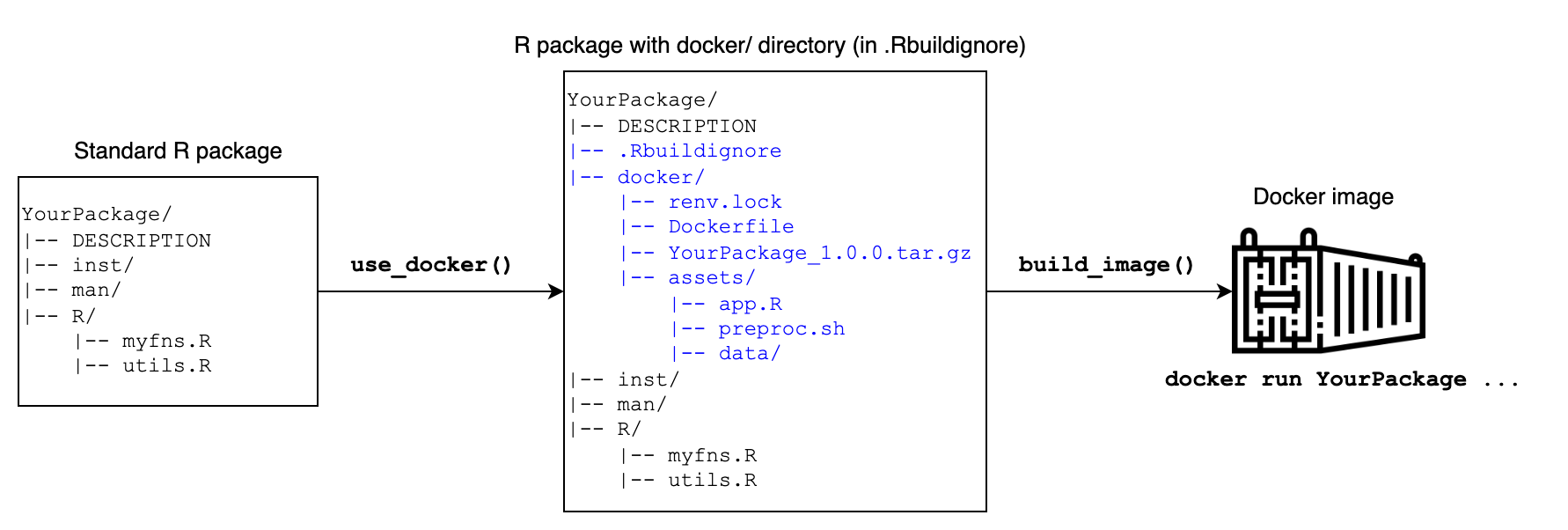

pracpac: Practical R Packaging with Docker
The goal of pracpac is to provide a usethis-like interface to create Docker images from R packages under development. The pracpac package uses renv by default, ensuring reproducibility by building dependency packages inside the container image mirroring those installed on the developer’s system. The pracpac package can be used to containerize any R package and deploy with other domain-specific non-R tools, Shiny applications, or entire data analysis pipelines.
Install pracpac from CRAN with:
install.packages("pracpac")Install the development version of pracpac from GitHub with:
# install.packages("devtools")
devtools::install_github("signaturescience/pracpac", build_vignettes = TRUE)Detailed documentation is available in the basic usage and use cases vignettes:
vignette("basic-usage", package="pracpac")
vignette("use-cases", package="pracpac")In the most simple example, running use_docker() inside
of a package directory will (1) capture all the package dependencies
installed on the developers system using renv, (2) build the package source
tar.gz, (3) create a Dockerfile which builds an image with the package
and its entire dependency chain, and (4) optionally builds a Docker
image with tags set using the version in the package
DESCRIPTION. The Dockerfile, renv.lock file,
and the package source tar.gz file will all be placed into a
docker/ subdirectory of the package, which is added to the
package’s .Rbuildignore. The workflow is shown in the
figure below.

For example, running use_docker() in the example package
included in pracpac at inst/hellow
will produce a Dockerfile with the following contents:
FROM rocker/r-ver:latest
## copy the renv.lock into the image
COPY renv.lock /renv.lock
## install renv and biocmanager
RUN Rscript -e 'install.packages(c("renv","BiocManager"), repos="https://cloud.r-project.org")'
## set the renv path var to the renv lib
ENV RENV_PATHS_LIBRARY renv/library
## restore packages from renv.lock
RUN Rscript -e 'renv::restore(lockfile = "/renv.lock", repos = NULL)'
## copy in built R package
COPY hellow_0.1.0.tar.gz /hellow_0.1.0.tar.gz
## run script to install built R package from source
RUN Rscript -e "install.packages('/hellow_0.1.0.tar.gz', type='source', repos=NULL)"And an renv.lock with the dependencies of
hellow (in this case just the praise
package):
{
"R": {
"Version": "4.0.2",
"Repositories": [
{
"Name": "CRAN",
"URL": "https://cran.rstudio.com"
}
]
},
"Packages": {
"praise": {
"Package": "praise",
"Version": "1.0.0",
"Source": "Repository",
"Repository": "CRAN",
"Hash": "a555924add98c99d2f411e37e7d25e9f",
"Requirements": []
}
}
}By default, use_docker() does not actually build the
image. You can build the image with build_image() after
running use_docker(), or in one step using
use_docker(build=TRUE). This two-step procedure is useful
because other use cases may require edits to the Dockerfile to install
system libraries, or copy in Shiny app or pipeline-specific code. See
the help
page for ?use_docker and the use
cases vignette
(vignette("use-cases", package="pracpac")) for details.